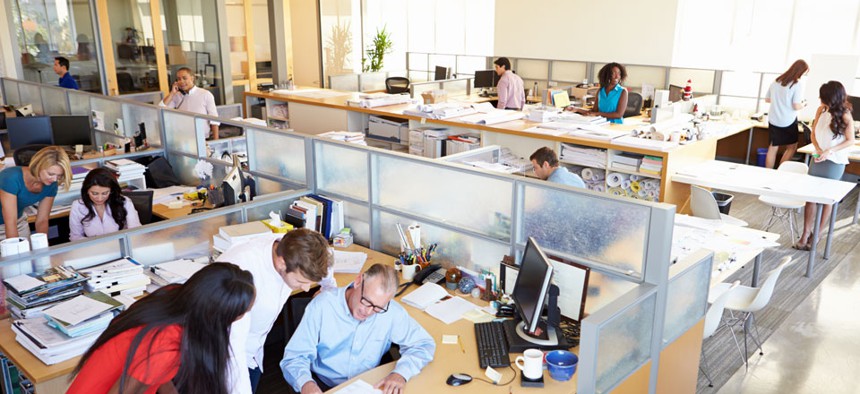Blame Open Plan Offices for Making Cold and Flu Season Worse
There's nowhere to hide from the guy with a cold.
The most popular office design in the United States is a large open plan office. People who have seen such offices half empty or full of sniffling people during the winter flu season won’t be surprised to hear they make people more likely to get sick.
Compared to people in mostly or partially private spaces, people in open plan offices of all sizes report taking more sick leave, according to a recent study. Open plan offices were connected to increased instances of sick leave lasting seven days or less, what you’d expect from an employee who caught a bad cold or the flu as opposed to something more serious. (The study doesn’t say whether the instances of sick leave correspond with actual diagnosed infections, but it’s probably safe to infer.) Workers in open plan offices with either four to nine people in the same room or more than 24 people were most likely to take sick leave.
Working in “flex offices,” which have open plans alongside private spaces for concentrated work or phone calls, increased the number of sick days for men in particular. It’s unclear why that may be.
This study, which looked at longitudinal data from 1,852 Swedish workers, seems to be the first to break out different office architectures in real detail. It looked at seven types, including individual private offices with windows, three sizes of open plan office, and hybrids.
Open plan offices make it easier to put more people in the same space. And there’s a management benefit in people being able to quickly talk to colleagues and managers. But they aren’t just potentially less hygienic, the authors say, there’s less personal control. When you have your own space, or at least a cubicle, you can isolate yourself from sick people better. That’s not an option when they’re right next to you.
The other possible reason is mental and environmental. There are more of what the authors call “negative environmental stimuli” in open offices, stuff like noise and the lack of privacy. That could lead people in open offices to take more sick days when they’re not ill, or to stay home when they’re feeling even a little under the weather.
People hoping for their own office shouldn’t get their hopes up. The trend isn’t towards giving people individual spaces, but refining the open plan.
“Our research has shown that it it doesn’t matter if you’re sitting in open office work station or an office, people are more distracted by technology and all of the things going on in their work environment,” Sonya Dufner, a workplace strategist at design firm Gensler told Quartz. ”With certain organizations we zone where those distractions, collisions, and meetings take place, so whether you’re in an office or work station, you have that possibility to put your head down and focus. As our desk spaces have gotten smaller and smaller and smaller, you need to be able to provide different areas for people to choose to go.”
In an open office, people more frequently choose to go home.
Reprinted with permission from Quartz. The original story can be found here.
(Image via Monkey Business Images/Shutterstock.com)



